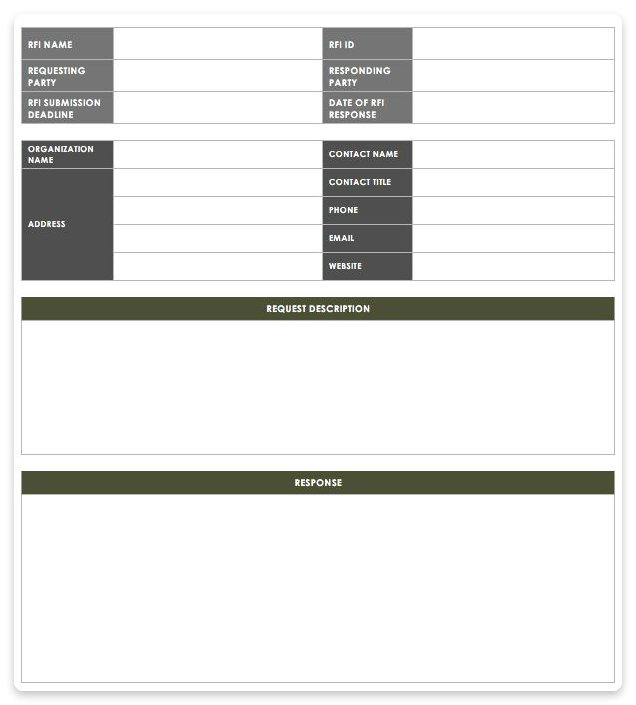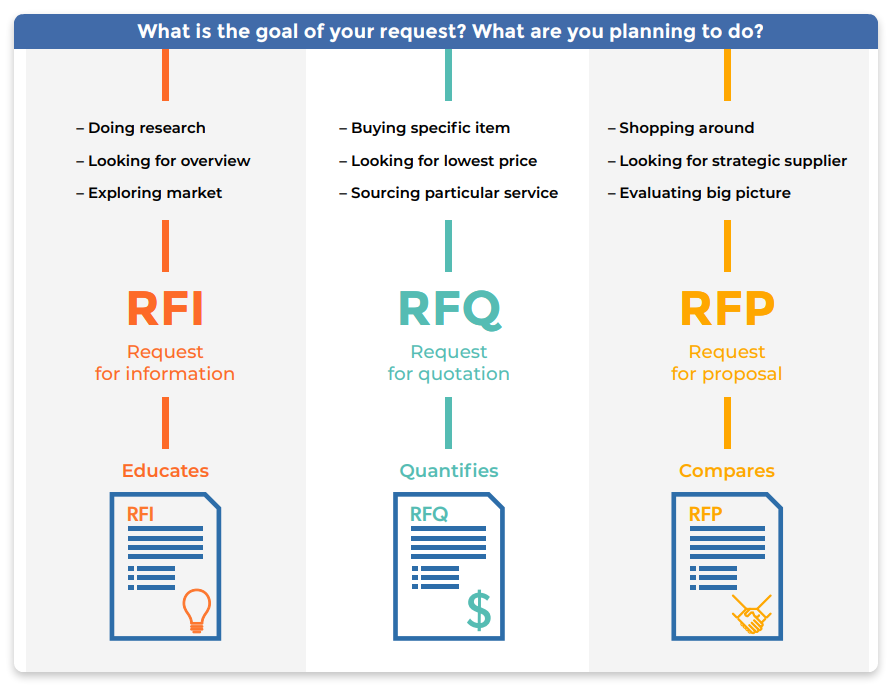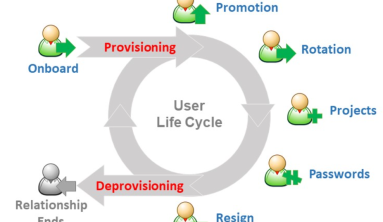RFI meaning
A request for information is better known by its acronym RFI. It’s a document that a company uses to request information about a product or service from suppliers. This way, the organization can get an idea of possibilities offered by each vendor, compare different providers, and gather information on a market in a more structured way.
RFIs are especially useful for companies that want or have to research many potential partners.
What information to include in an RFI?
There is no set way to write an RFI. Each business decides what specific information it wants to collect from different suppliers. Also, it chooses the number of details it wants to request.
Still, it doesn’t mean that every RFI is that different. There are several specific elements that you usually include in you request for information form:
- Basic information about your company (such as business activity and contact details).
- A request to the supplier to fill in basic information about their organization (such as business activity and contact details).
- Confidentiality agreement to prevent providers from sharing information with third parties.
Aside from the information above, there is a wide variety of different things a business can request. Below is a non-exhaustive list of common elements:
- Presentation of the applicant company.
- Statement of the reason for the RFI.
- Questions about the vendor’s experience with similar projects.
- Questions about the supplier’s action plan, financial situation, and technical skills.
- Clients’ references.
- Selection criteria matrix based on which the requesting company will choose the supplier.
Did you know? Some businesses ask providers to solve a case based on a realistic scenario. This way, you get the advantage of testing the supplier’s dedication to the project. However, doing it this way requires more effort and time to compare different vendors and their techniques.

How to write a request for information
With so many elements to choose from, we’ve compiled a short RFI template that covers basic points that should be included to communicate your needs to potential providers:
Overview
It should describe your business’s background, goals, objectives, and confidentiality policies. At the end of this part, the supplier will get an overall image of who the requesting company is and what it wants.
Qualifications
Here you can include the skills and credentials required for your project. Specify everything you need: the size of the team, technical restrictions, operation systems, level of experience, etc.
Requested information
This section contains specific questions about the supplier’s infrastructure, working methods, credibility, project management, quality control, and more. The information must be obtained to know if the supplier is viable for the project or not.
Response expectations
This part should describe what is expected in terms of information and deadline. You can also include evaluation criteria here.
Some tips for developing good RFI are:
- Restrict your request just to the information you need.
- Try to be as specific in your request as possible.
- Ask about capabilities and resources. Price isn’t discussed at this stage.
- Give your vendor a fair amount of time for response.
What is the difference between RFI, RFP, and RFQ?
We’ve dealt with the RFI definition, but you might still be confused since there are so many similar terms and acronyms. But don’t worry, we’ve got you covered.
Often, RFI, RFP, and RFQ are used interchangeably, but this is wrong. All these notions have their meaning and reason for existing.
Let’s dive deeper into them.
RFP: Request for proposal
An RFI generally precedes a request for proposal (RFP). An RFP is a document in which you ask different vendors to propose solutions to your problems and request information about the price of their product or service.
This is a more complex request where you should detail both the starting point and what is expected to be achieved, not only in economic terms but also in terms of quality, safety, execution, etc.
Without going into much detail, an RFP should contain:
- A confidentiality agreement, if necessary.
- Information about your business.
- Objectives of the hiring process (i.e., needs that are expected to be covered).
- Description of the current situation and needed improvements in as much detail as possible.
- Details on the execution of the project, if successful.
- Calendar of phases of the process (presentation of the proposal, decision-making, start of the project, etc.)
Although RFPs usually follow RFIs, they can also be combined in certain cases. Due to tenders, this combination occurs frequently in government agencies. By doing it this way, all the relevant information is gathered to make the first selection.
RFQ: Request for quotation or budget request
The objective of an RFQ or request for quotation is to ask different suppliers about the price of a specific service or product. It’s used when you are committed to buying and judge the solution primarily on price.
In this case, you ask the supplier to give a budget for a specific product or service, making it easy to compare proposals since they are budgeting for the same thing.
In this case, the information that an RFQ must contain is:
- Information about your company (business activity and contact details).
- Specific request on the price of a product or service offered by the supplier, specifying in detail what this product or service should include.
- Request to sign a confidentiality agreement, if necessary.
- Deadlines for submitting the budget and next steps for the project.
- Criteria that will be taken into account when deciding.

Wrapping up
As you can see, RFIs are less specific and contain less information than RFPs or RFQs. However, their advantage is that they are less complex to prepare and can help you filter out suppliers from the beginning if you already see that they don’t offer what you want.
A good RFI request will obtain answers and key information to make the supplier viable, forming a portfolio of vendors of great value for future purchasing strategies. It’s a simple way to carry out a comparison between vendors if what you want is to quickly contract a small project.





